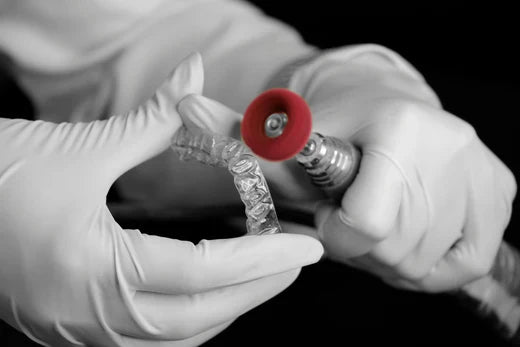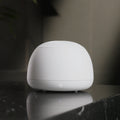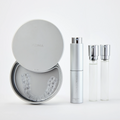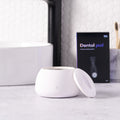
How long will my retainers last? (2025)
Retainers are essential tools for maintaining the shape of teeth. From wire and acrylic Hawley retainers to Essix clear plastic retainers, they are designed to preserve the results achieved by lengthy (and often expensive) orthodontic treatment.
Although retainers are intended to last up to 10 years, there are a number of factors that can shorten their lifespans and result in a costly replacement. As seen in this study, a retainer’s life cycle frequently ends with one of the following: fracture (most common), loss, ‘no longer fitting’ or the formation of holes. Research has found that, depending on the type of retainer and materials used to make it, they are often unusable after just 100 days. This article will delve into both the importance of looking after your retainer and how to get the most out of your investment for years to come.
What are retainers made with?
Retainers are made with a variety of different materials, with higher quality and more durable options naturally lasting longer than their cheaper counterparts. Read on to learn about the different types of retainers and what they are made with.
Essix retainers are made with clear plastic, a slightly thicker version of Invisalign aligners, and are moulded in the exact shape of your straightened teeth. Clear retainers provide a discreet and easily removable solution that patients find more comfortable, but can be easier to misplace and need to replace.
Bonded wire retainers sit along the back of your teeth as a fixed, ‘permanent’ solution that is estimated to last up to three years. Whilst invisible, they can be harder to clean and risk ‘unbonding’ from your teeth when the glue is exposed to the daily wear and tear of eating and drinking.
Traditional Hawley retainers are a more durable and easily repairable option. Also moulded to the shape of your teeth, they are constructed with wire and acrylic, which can be adjusted in future. Along with the durable materials used, adjustments help patients get more out of their retainers for longer.
How often and when you wear your retainer can impact its longevity. Orthodontists usually recommend wearing your retainer day and night directly after the end of your treatment, and every night thereafter. Wearing it at night, when you won’t be eating or drinking, helps maintain your retainer’s clarity of colour and integrity.
How can you make your retainer last longer?
Whilst retainers will always be subject to natural wear and tear, one study on the average survival time of retainers cited the two main reasons for needing replacements as fracture and loss. Please see below for preventative steps you can incorporate into your oral health routine to help preserve your retainer long-term.
Fracture
Recorded as the most common reason for damage to retainers, fracture and structural weakness can be caused by a variety of controllable and uncontrollable factors. Medical conditions such as Bruxism, known as teeth grinding or clenching, which affects nearly 1 in 10 American adults, can weaken and put additional strain on your retainer. Controllable habits also have a role to play in damaging your retainer. Eating hard and sticky foods and forgetting to keep your retainer out of reach of children and pets should be avoided to prevent breakage.
Additionally, many people opt for cleaning methods that harm the integrity of retainers and make them more susceptible to breakage. Using hot water, including putting your retainers in the dishwasher or boiling water, can warp and distort their shape. When your retainers change shape, they no longer serve their purpose and are in need of replacing. Scrubbing your retainers with a toothbrush, even soft-bristled, and silica toothpaste causes microabrasions to the surface of retainers, making them more brittle. Cleansing tablets often contain corrosive ingredients, harmful to both your retainer but also to your health, as they can be too harsh for your retainer’s delicate plastic. Always check the ingredients and ensure that the tablets you use are suitable for your retainer type. Find out more here.
Zima Dental’s Dental pod utilises the power of high frequency 42,000hz ultrasonic waves, which do all the work to dislodge plaque, stains and food particles from your retainer. Using this clinical grade ultrasonic technology designed specifically for oral appliances is a safe, effective and convenient way to sterilise your retainers without the nasty side effects of other methods. It runs on a self-timed 5-minute cycle with just tap water, providing a gentle and non-abrasive clean for your retainers. Engineered with a thermoregulated tank, the Dental pod controls the temperature of the water to ensure that your retainer’s custom shape is not distorted.
To further avoid distorting or thinning your appliance, do not bite your clear plastic retainer into place as this can damage the surface of the appliance. Retainers are usually made with a thicker plastic than aligners, which need to be discreet and easy to speak with, but are still flexible and fragile. Research has found that clear plastic retainers are particularly susceptible to cracking and the formation of holes and gaps, rendering the appliance unusable.
Loss
Loss is known to be another common reason for retainer replacement, an easy fix being to store your retainer safely. Opting for a robust and reliable protective case is often an overlooked yet vital aspect of retainer care. The Zima Go’s durable material composition and secure closure mechanism make it a reliable alternative to cheap and flimsy plastic cases.
This multifunctional case also serves as a sterilisation device, with in-built UV sterilisation technology. Retainer care is important for maintaining both your orthodontic investment and your health overall, with studies showing that poorly cleaned retainers can harbour harmful bacteria and microbes like Lactobacillus and Streptococcus mutans bacteria, particularly with repeated use. An easy to use and durable protective case will help avoid damage, exposure to bacteria and prolonged sunlight. Even after a thorough clean, bacteria will start to colonise on the surface of your retainer once exposed to the environment. The Zima Go ensures that your retainer is stored securely and is sealed in a bacteria-free environment at all times, even when travelling.
At the end of what can be long, expensive and painful orthodontic treatment, it is important to look after the appliance that will make it all worthwhile. Schedule regular check-ups with your orthodontist to ensure your retainer fits properly and is in good condition. Following cleaning, storage and usage advice will help preserve the lifespan of your appliance and avoid the need for costly repairs or replacements.















Leave a Comment